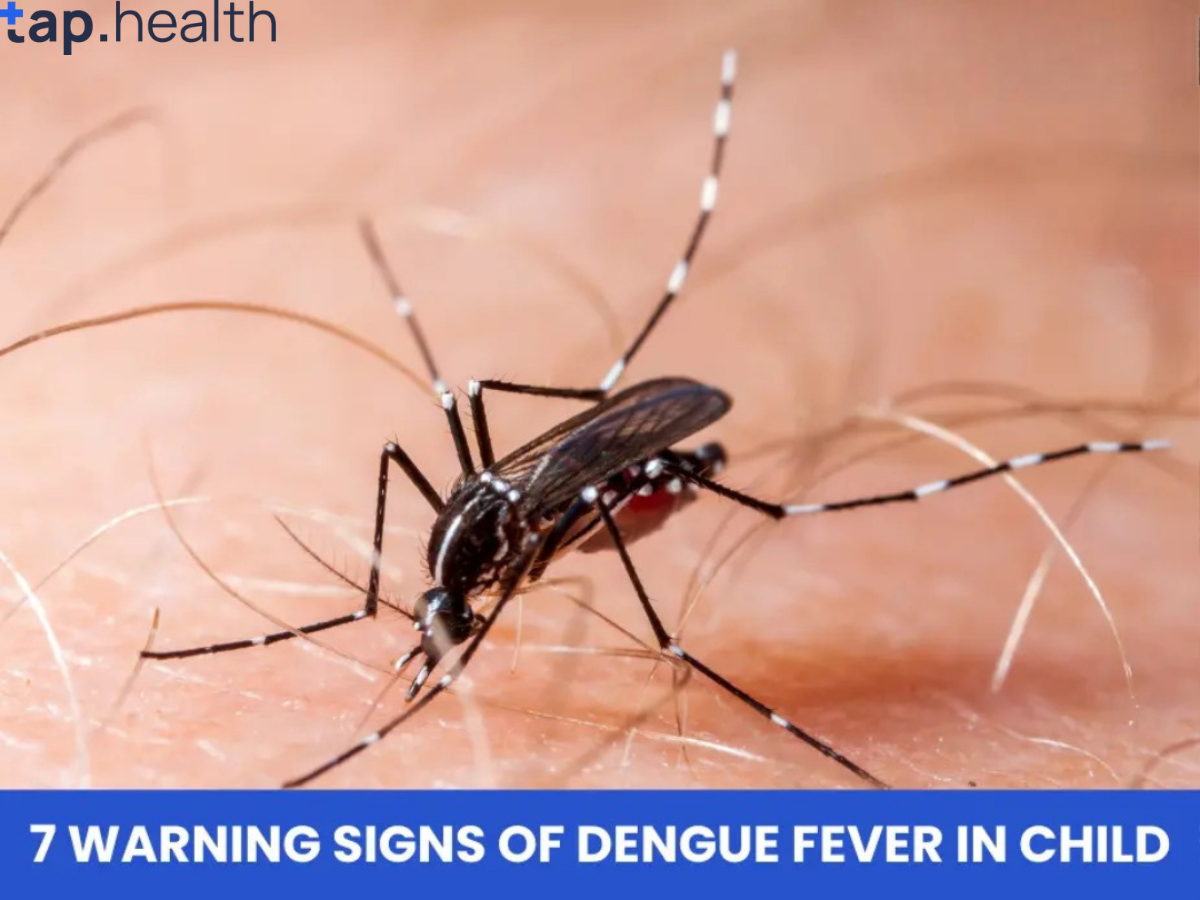As a parent, keeping your child healthy and safe is always a top priority. But sometimes, illnesses can sneak up on us, especially tricky ones like dengue fever. This blog post will help you understand dengue fever, its symptoms, and most importantly, the warning signs to watch out for in your children. Let’s dive in and learn how to protect our little ones from this pesky mosquito-borne disease.
What is dengue fever?
Dengue fever is like an unwelcome guest that mosquitoes bring to our homes. It’s a viral infection spread by certain types of mosquitoes, mainly the Aedes aegypti mosquito. These mosquitoes are sneaky daytime biters, so you need to be on guard all the time.
Imagine dengue fever as a really bad flu but with some extra twists. It can make you feel awful, with high fever, body aches, and sometimes even more serious problems. The tricky part is that it can look like other illnesses at first, which is why it’s important to know what to look out for.
Types of dengue fever
Dengue isn’t just one disease – it comes in different forms, each with its level of severity. Understanding these types can help you better grasp what your child might be facing if they contract dengue.
1. Mild Dengue Fever
This is the most common form of dengue. While it’s certainly not pleasant, it’s usually not life-threatening if properly managed. Symptoms typically include high fever, severe headache, pain behind the eyes, muscle and joint pain, and fatigue. Think of it as a really bad case of the flu but with some extra aches and pains thrown in.
2. Dengue Hemorrhagic Fever (DHF)
This is a more severe form of dengue. In addition to the usual dengue symptoms, DHF can cause bleeding (haemorrhage) from various parts of the body. This might show up as nosebleeds, bleeding gums, or easy bruising. In severe cases, it can lead to internal bleeding. DHF is like dengue fever’s mean big brother – it needs to be taken very seriously and requires immediate medical attention.
3. Dengue Shock Syndrome (DSS)
This is the most severe and life-threatening form of dengue. It occurs when the blood vessels start to leak fluid, causing the blood pressure to drop dangerously low. This can lead to shock, organ damage, and even death if not treated promptly. DSS is the worst-case scenario in dengue infections, and it’s the reason why early detection and proper care are so crucial.
Here’s where things get a bit complicated. There are four distinct types (or serotypes) of the dengue virus, cleverly named DENV-1, DENV-2, DENV-3, and DENV-4. If a person is infected with one type, they become immune to that particular type for life. However – and this is important – they are not protected against the other three types.
If someone who has previously had dengue gets infected with a different type, they’re at higher risk of developing severe dengue (DHF or DSS). It’s like the body’s immune system gets confused and overreacts, potentially making the situation worse.
This is why dengue can be particularly tricky in areas where multiple types of the virus are circulating. A child who had a mild case of dengue one year could potentially have a more severe case if infected with a different type the next year.
Understanding these different types of dengue helps explain why the disease can be so unpredictable and why medical professionals take it so seriously, even in seemingly mild cases.
What are the dengue fever symptoms?
Recognizing the symptoms of dengue fever is crucial for early detection and treatment. While not every child will experience all of these symptoms, being aware of the possible signs can help you catch the disease early. Here’s a detailed look at 15 common symptoms of dengue fever:
- High Fever: This is often the first and most noticeable sign. The fever in dengue is typically high, often reaching 40°C (104°F) or higher. It usually comes on suddenly and may last for 2-7 days.
- Severe Headache: Many children with dengue complain of intense headaches. These are often described as a pounding pain, particularly behind the eyes.
- Pain Behind the Eyes: This is a characteristic symptom of dengue. The pain may worsen when the child moves their eyes.
- Muscle and Joint Pains: These can be severe, which is why dengue is sometimes called “breakbone fever.” Your child might complain that their whole body hurts.
- Fatigue: Extreme tiredness is common. Your child might seem unusually lethargic or lack energy.
- Nausea: Many children with dengue feel queasy or sick to their stomach.
- Vomiting: This can range from occasional to frequent and severe.
- Skin Rash: A rash may appear 2-5 days after the fever starts. It usually begins on the trunk and spreads to the arms, legs, and face.
- Mild Bleeding: This can manifest as nosebleeds, bleeding gums, or easy bruising. In girls, heavier menstrual periods might occur.
- Loss of Appetite: Your child might refuse food or eat much less than usual.
- Abdominal Pain: Some children experience severe abdominal pain, which can be a warning sign of severe dengue.
- Persistent Vomiting: While some vomiting is common, persistent vomiting (unable to keep anything down) is a warning sign.
- Rapid Breathing: If your child’s breathing becomes noticeably faster, it could indicate fluid accumulation in the lungs, a serious complication.
- Blood in Vomit or Stool: This is a severe symptom that requires immediate medical attention. The blood in vomit might look like coffee grounds.
- Cold, Clammy Skin: In severe cases, as the fever breaks, the skin might become cold and clammy, especially if the child is going into shock.
Remember, these symptoms can appear in various combinations and severities. Some children might have only a few mild symptoms, while others may experience many severe ones. The key is to stay vigilant and seek medical attention if you suspect dengue, especially if your child shows any of the warning signs we’ll discuss later.
What are the Causes of dengue fever?
Dengue fever is caused by a virus, but it needs a little helper to spread – the mosquito. Here’s how it works:
- An infected mosquito bites a person.
- The virus enters the person’s bloodstream.
- The virus multiplies.
- The person gets sick.
- Another mosquito bites the sick person.
- This mosquito becomes infected.
- The infected mosquito bites more people.
It’s like a not-so-fun game of tag, with mosquitoes passing the virus from person to person. The main culprit is the Aedes aegypti mosquito, but its cousin, the Aedes albopictus, can spread it too.
These mosquitoes love warm, wet places and can breed in tiny amounts of standing water. That’s why dengue is more common in tropical and subtropical areas, especially during rainy seasons.
What are the Risk factors of dengue fever?
Some people are more likely to get dengue fever or have worse symptoms. Here are some risk factors to keep in mind:
- Living in or travelling to tropical areas: If you live in or visit places like Southeast Asia, the Caribbean, or parts of South America, you’re more at risk.
- Previous dengue infection: Remember how we said getting a different type of dengue can be worse? That’s a risk factor.
- Age: Young children and older adults can have more severe symptoms.
- Weak immune system: If your body’s defence system isn’t working well, dengue can hit harder.
- Pregnancy: Pregnant women need to be extra careful as dengue can affect both mom and baby.
- Overcrowded areas: More people means more chances for mosquitoes to spread the virus.
- Poor sanitation: Standing water and trash give mosquitoes places to breed.
- Lack of mosquito control: If your area doesn’t spray for mosquitoes or educate people about prevention, the risk can be higher.
7 warning signs of dengue fever in children
Now, let’s get to the heart of the matter. When it comes to children, seven key warning signs might mean dengue fever has taken a serious turn. Keep a close eye out for these:
1. Severe abdominal pain
If your child complains of intense tummy pain, especially if it comes on suddenly, take it seriously. This could mean internal bleeding.
2. Persistent vomiting
We’re not talking about throwing up once or twice. If your child can’t keep anything down for several hours, it’s time to worry.
3. Rapid breathing
If your child is breathing faster than usual or seems to be struggling to breathe, it’s a red flag.
4. Bleeding gums
Take a peek in your child’s mouth. If their gums are bleeding without any apparent reason (like brushing too hard), it could be a sign of dengue.
5. Fatigue or restlessness
Extreme tiredness or, on the flip side, unusual restlessness can both be warning signs.
6. Cold, clammy skin
If your child’s skin feels cold and damp, especially if they have a fever, it’s concerning.
7. Blood in vomit or stools
This is a serious sign that needs immediate medical attention. Check for any signs of blood when your child uses the bathroom or throws up.
Remember, these signs usually show up as the fever starts to go down, usually around days 3-7 of the illness. This is known as the critical phase, and it’s when things can get dangerous if not managed properly.
What are the Prevention of dengue fever?
The best way to deal with dengue is to avoid getting it in the first place. Here are some tips to keep those pesky mosquitoes away:
- Use mosquito repellent: Apply repellent to exposed skin, especially during the day when Aedes mosquitoes are most active.
- Wear protective clothing: Long sleeves and pants can help, especially if treated with insecticide.
- Use mosquito nets: These can be helpful, especially for young children or when sleeping during the day.
- Install screens: Put screens on windows and doors to keep mosquitoes out.
- Eliminate standing water: Get rid of any standing water around your home where mosquitoes might breed.
- Keep your yard tidy: Cut grass and bushes short, as mosquitoes like to rest in dark, shady areas.
- Stay indoors during peak mosquito hours: If possible, avoid being outside during early morning and late afternoon.
- Support community efforts: Participate in local mosquito control programs.
Remember, preventing mosquito bites is the key to preventing dengue. It’s all about making your environment less mosquito-friendly.
What are Treatments for dengue?
There’s no specific medicine that kills the dengue virus. Treatment is all about managing the symptoms and preventing complications. Here’s what doctors usually do:
- Rest and fluids: Lots of bed rest and plenty of fluids to prevent dehydration.
- Pain relievers: Acetaminophen (like Tylenol) can help with fever and pain. Avoid aspirin or ibuprofen as they can increase bleeding risk.
- Monitoring: Close monitoring of symptoms, especially during the critical phase.
- Platelet transfusions: In severe cases, this might be necessary to help with blood clotting.
- Intravenous fluids: If dehydration is severe, fluids might be given through a vein.
- Supportive care: Treating specific symptoms as they come up.
The good news is that most people recover from dengue with proper care. The key is catching it early and getting the right treatment.
When to See a Doctor
It’s always better to be safe than sorry when it comes to dengue. Here’s when you should definitely take your child to see a doctor:
- If you suspect your child has been bitten by a mosquito and develops a fever.
- If your child shows any of the 7 warning signs we discussed earlier.
- If symptoms persist or get worse after 3-5 days.
- If your child has recently traveled to an area where dengue is common and develops symptoms.
- If you’re unsure and worried – trust your parental instincts!
Remember, early treatment can make a big difference in how well your child recovers from dengue.
FAQ on 7 warning signs of dengue fever in child
1: How long does dengue fever last in children?
A: Typically, dengue fever lasts about a week, but the recovery period can extend to several weeks.
2: Can dengue fever be fatal in children?
A: While most cases are not fatal, severe dengue can be life-threatening if not treated promptly.
3: How can I tell if my child has dengue or just a regular flu?
A: It can be tricky, but dengue often includes symptoms like severe headache, pain behind the eyes, and muscle and joint pains, which are less common in regular flu.
4: Are there any long-term effects of dengue fever in children?
A: Most children recover fully, but severe cases can sometimes lead to organ damage.
5: Can my child get dengue fever more than once?
A: Yes, it’s possible to get dengue multiple times, and subsequent infections can be more severe.
6: Is there a vaccine for dengue fever?
A: There is a vaccine, but it’s only recommended for children who have had a confirmed dengue infection in the past.
7: How can I protect my child from dengue fever at school?
A: Encourage your child to use mosquito repellent, wear protective clothing, and avoid areas where mosquitoes might breed.
References
- World Health Organization. (2022). Dengue and severe dengue. https://www.who.int/news-room/fact-sheets/detail/dengue-and-severe-dengue
- Centers for Disease Control and Prevention. (2023). Dengue. https://www.cdc.gov/dengue/index.html
- National Institute of Allergy and Infectious Diseases. (2021). Dengue Fever. https://www.niaid.nih.gov/diseases-conditions/dengue-fever
- Mayo Clinic. (2022). Dengue fever. https://www.mayoclinic.org/diseases-conditions/dengue-fever/symptoms-causes/syc-20353078
- American Academy of Pediatrics. (2021). Dengue. https://www.healthychildren.org/English/health-issues/conditions/tropical/Pages/Dengue.aspx
Remember, while this information is helpful, it’s not a substitute for professional medical advice. Always consult with a healthcare provider if you’re concerned about your child’s health.



